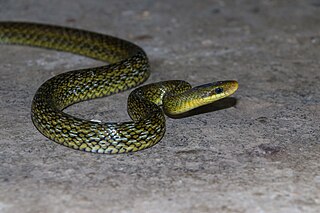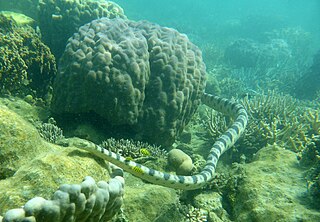
Elaphe hodgsoni, the Hodgson's rat snake, is a species of snake in the family Colubridae. The species is found in parts of Asia around the Himalayas.

Sibynophis collaris, commonly known as the common many-toothed snake,Betty's many toothed snake or the collared black-headed snake, is a species of colubrid snake endemic to South and East Asia.

The olive-headed sea snake, also known as the greater sea snake, is a species of venomous sea snake in the family Elapidae.

Hydrophis melanocephalus, commonly known as the slender-necked sea snake, is a species of venomous sea snake in the family Elapidae.

Elapotinus is a monotypic genus created for the rear-fanged snake species, Elapotinus picteti. The species is endemic to Madagascar. It is also known commonly as Jan's snake in honor of Italian herpetologist Giorgio Jan. There are no subspecies that are recognized as being valid.

Macrelaps is a monotypic genus created for the rear-fanged (opisthoglyphous) venomous snake species, M. microlepidotus, endemic to South Africa. No subspecies are currently recognised.
The Cameroon racer, Poecilopholis cameronensis, is a species of rear-fanged mildly venomous snake endemic to Africa. Poecilopholis is a monotypic genus created for this species.
Aparallactus lineatus, or the lined centipede-eater, is a species of mildly venomous rear-fanged snake in the family Atractaspididae.
Aparallactus niger is a species of mildly venomous rear-fanged snake in the family Atractaspididae. It is endemic to Western Africa.
Polemon acanthias, or Reinhardt's snake-eater, is a species of mildly venomous rear-fanged snake in the family Atractaspididae. It is endemic to Africa.
Polemon barthii, or the Guinea snake-eater, is a species of rear-fanged mildly venomous snake in the family Atractaspididae. The species is endemic to Africa.
Polemon christyi, also known commonly as Christy's snake-eater and the eastern snake-eater, is a species of mildly venomous rear-fanged snake in the subfamily Aparallactinae of the family Atractaspididae. The species is native to Central Africa and East Africa.

Polemon collaris, or the collared snake-eater, is a species of mildly venomous rear-fanged snake in the family Atractaspididae. It is endemic to Africa.
Polemon gabonensis, or the Gaboon snake-eater, is a species of mildly venomous rear-fanged snake in the family Atractaspididae. It is endemic to Africa.
Polemon gracilis, or the graceful snake-eater, is a species of mildly venomous rear-fanged snake in the family Atractaspididae. It is endemic to Africa.

Polemon notatus is a species of mildly venomous rear-fanged snake in the family Atractaspididae. It is endemic to Africa.

Aparallactus guentheri, or the black centipede-eater, is a species of mildly venomous rear-fanged snake in the family Atractaspididae. The species is endemic to Africa.
Aparallactus jacksonii, or Jackson's centipede-eater, is a species of mildly venomous rear-fanged snake in the family Atractaspididae.

Aparallactus modestus, or the western forest centipede-eater, is a species of mildly venomous rear-fanged snake in the Atractaspididae family.
Aparallactus werneri, or the Usambara centipede-eater, is a species of mildly venomous rear-fanged snake in the family Lamprophiidae. The species is endemic to Tanzania.










